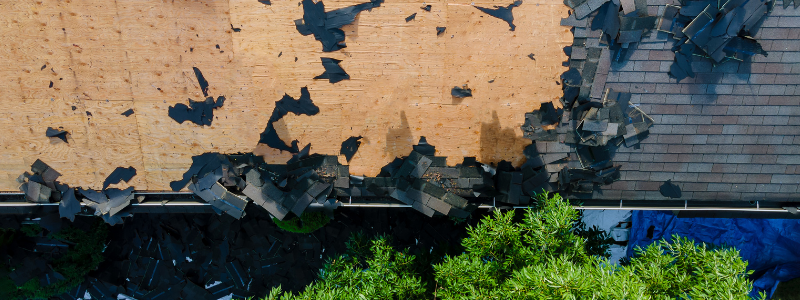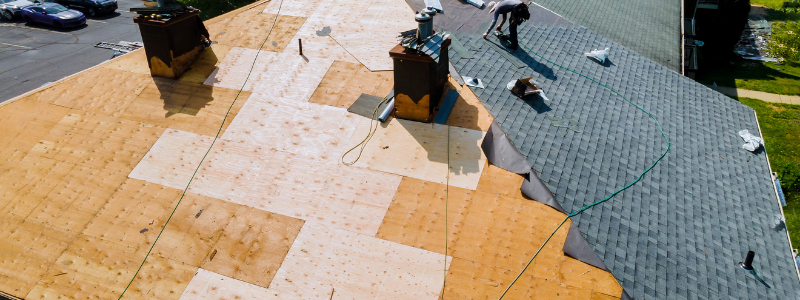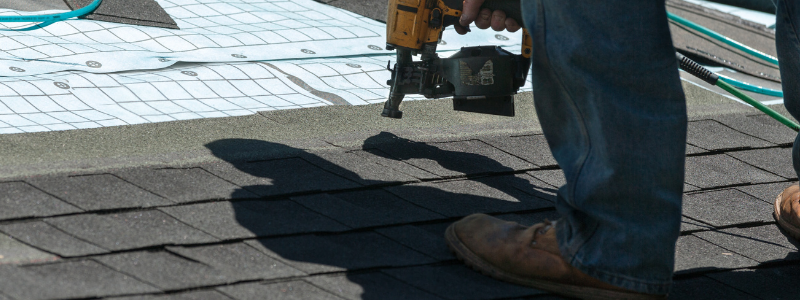
Roof Overlay vs Tear Off
There are many good reasons to replace your worn-out roof. You provide better protection from the weather. Failure to replace a damaged or aging roof can result in moisture buildup. Molds, mildew, bacteria, and standing water may cause health hazards or erode the structure of your house.
A new roof increases the value of your home and adds to its curb appeal for resale purposes. IKO.com cites a new roof as a powerful marketing tool in adding to your home’s value.
The National Association of the Remodeling Industry estimates that a new roof will recoup nearly 70% of the cost when you sell your house.
If your roof is showing signs of wear, you have two options: Roof overlay vs tear off. Each has advantages and disadvantages.

Reroofing and Roof Replacement
The Miriam Webster Dictionary defines reroofing as the process of recovering or replacing an existing roof material or replacing all parts of the roof of a building. Depending on the amount of damage to the roof, a roof replacement is the best option.
Reroofing Options
If you choose roof overlay, professional roofers will simply install an additional roof covering over the existing roofing material without removing the layer already in place. However, if you choose to tear off, the roofers will remove the existing damaged or worn material and replace it with new roofing materials.
What is Roof Overlay?
An overlay roof, or the process of overlaying a roof, occurs when a roofing technician puts another set of roofing materials directly on top of the existing roof.
Roof overlay isn’t the most common method of roofing repair or replacement but it is one option.
Difference Between Overlay vs. Tear Off
When the tear-off option of roof replacement is chosen, roofing specialists tear off the existing roofing material and put on a new one. Whereas with overlay, they do not remove the roofing materials first.

Advantages of Tear Off
Select New Material
With a roof tear off occurs, every part of the roofing material is replaced with new materials. If your decking or underlayment were deteriorating, that problem will be solved. Your roofer can also find and repair any developing cracks, holes, or leaks. This protects your whole home from mold, mildew, and rot.
Upgrade Materials
Construction companies build to sell. Often, they don’t use the highest quality materials. If you are replacing a roof, you can upgrade the roofing materials.
With expert input from your roofing company, you can choose the best materials for your roof. You could upgrade the oriented strand board to CDX plywood decking. You might opt for synthetic roof underlayment instead of standard-issue felt.
Respond to Climate Conditions
Colorado has challenging weather conditions. Your roof may have to withstand extremes of cold and heat. Heavy rains and snow challenge roofing materials. When you repair or replace your roof, you can choose the best materials for your climate conditions. This will improve the heating/cooling efficiency and save you money on your energy bills.
Add More Durability
When your roof is made of all-new materials, it will last longer and will be more durable to wind, heat, and water challenges.
When old materials are torn off, your roofing specialist has a chance to examine the structure of the roof. If needed, repairs can then be made. This means serious damage is often averted.
Increase Roof Life
With the installation of a new roof, the materials can last twenty to thirty years. This is up to ten years more than the expected life of an overlay.
Improve Assessed Property Value
Realtors estimate that a new roof can add over $10,000 to your home’s resale value. A new roof is a strong selling point. While an overlay offers a fast, inexpensive fix, a tear off is a smart choice. It increases the appraised value of your home.
Disadvantages of a Tear Off
Increased Cost
It is estimated that a tear off roof replacement will cost a quarter more than an overlay. Labor costs include completely removing the existing roofing material and replacing the layers removed.
Waste Removal
The old roofing must be disposed of. This adds to the time and labor costs. It also creates clutter and potential injury to shrubs, lawns, and homeowners.

Advantages of a Roof Overlay
Overlays are Less Labor Intensive
Roofing companies may suggest putting a new layer of shingles over an existing layer. This takes significantly less time. The old roof doesn’t need to be torn off. Thus, the time to replace the roof is cut by at least 25%.
Overlays are Faster
An overlay can be finished days sooner. That is time you won’t be inconvenienced by having to be away from or trapped inside your house.
Overlays are Less Expensive
Estimates indicate that an overlay is at least 25% less expensive than a tear off.
A Roof Overlay is Easier
Overlays eliminate collecting and disposing of old roofing materials. There’s no need to order, store, and get rid of a dumpster to collect old roofing materials.
Roof overlay is Safer
With an overlay, there is no danger of falling roofing materials or roofing nails that could get stepped on.
Overlays have a Viable Life
An overlay is a viable option if the existing roofing materials have not already been overlaid. Home Reference.net notes that on average you can expect the overlay to last for fifteen or sixteen years.
Overlay Shingles are Guaranteed
The shingle warranty is the same whether the roof is a total replacement or an overlay.
Overlays are Great for Quick Sales
If you are planning to sell the house, using an overlay will significantly cut the cost of roof replacement. Roof overlay is a faster, cheaper, more short-term remedy.
Disadvantages of Overlays
Possible Increased Costs
One thing to consider is the possible long-term bad effects of an overlay. It is possible that what seemed like an economical way to repair your roof could end up costing you more money.
Weight Safety Factor
Another consideration is the weight factor. If your present roof is losing granules and you put a new roof on top, this adds stress to the roof structure. The original design may not be able to bear the extra layer.
Structural Problems Could be Missed
By using the overlay option, you don’t have an opportunity to examine the condition of the roof structure. It may be rotted or damaged. There may be holes or weak spots in the underlayer that need to be reinforced or replaced.
Roof Parts Could be Compromised
When you opt for an overlay instead of a tear off the flashings around the sidewalls and roof penetrations may be compromised. This will allow water to get into your house. It may also rot the roof structure.
Roof Overlay vs Tear Off
When it comes to deciding between roof overlay vs tear off, there’s one option that is the better, more sustainable route. Many roofing companies (including us) do not recommend layering a new roof on top of the existing roof material. While roof overlay is a short-term, economical solution, it may not be the safest one for your home or your family.
Good roofing practice would be a complete tear off vs a roof overlay. By tearing off the old roof, you have a chance to examine the roof structure and make repairs if any are needed. When you overlay, you are trusting that there is no sheathing rot, or ice, or water damage. If you are certain that there are no leaks, cracks, or rot, then overlay might be the way to go.
By choosing overlay over tear off you aren’t giving yourself an opportunity to install an ice and water-leak barrier. This could result in leakage under the old roof.
FAQ: Roof Overlay vs Tear Off
What is the difference between roof overlay and tear off? Roof overlay involves installing a new layer of roofing materials directly over the existing roof, without removing the old materials. Tear off, on the other hand, involves completely removing the existing roofing materials and replacing them with new ones.
Which option is recommended by roofing experts? In general, most roofing experts recommend tear off as the better, more sustainable option. It allows for a thorough inspection of the roof structure and the opportunity to address any underlying issues. However, if the existing roof is in good condition with no leaks, cracks, or rot, overlay may be a viable choice.
What are the advantages of tear off? Tear off offers several advantages, including:
- Ability to select new materials and upgrade the roofing system
- Improved response to climate conditions and increased durability
- Longer roof lifespan compared to overlay
- Enhanced assessed property value and potential for higher resale value
What are the advantages of roof overlay? Roof overlay has certain advantages, including:
- Less labor-intensive and faster installation process
- Lower overall cost compared to tear off
- Easier disposal of old roofing materials
- No risk of falling roofing materials or nails during installation
Are there any disadvantages to tear off? Tear off does have a few disadvantages to consider, including:
- Increased cost due to complete removal and replacement of roofing materials
- Waste removal, which adds to the time, labor, and potential clutter
What are the disadvantages of roof overlay? Some potential drawbacks of roof overlay include:
- Possible long-term effects that may end up costing more money
- Weight safety factor, as adding another layer may stress the roof structure
- Missed opportunities to identify underlying structural problems
- Compromised roof parts, such as flashings, which may lead to water damage
Which option is more cost-effective? Roof overlay is generally less expensive compared to tear off since it requires less labor and materials. However, it’s important to consider the long-term costs and potential risks associated with overlay.
How long does an overlay last? On average, an overlay can be expected to last around fifteen to sixteen years, provided that the existing roofing materials have not already been overlaid.
Can an overlay be a good option for a quick house sale? Yes, if you are planning to sell the house in the near future, opting for a roof overlay can significantly reduce the cost of roof replacement. It provides a faster and cheaper solution for short-term needs.
Can an overlay compromise the roof’s ability to prevent leaks? Yes, by choosing an overlay instead of a tear off, you may miss the opportunity to install an ice and water-leak barrier. This could potentially result in leakage under the old roof.
B&M Roofing and Residential Roofing
B&M Roofing has extensive experience in residential and commercial roofing, with a Colorado company providing quality service throughout the Centennial State since 1947.
The premier Colorado commercial roofing contractor uses only the highest quality roofing shingle suppliers: GAF and Owens Corning. We offer a wide range of colors and styles to choose from, ensuring that we can match the right roof shingle color to any home’s style.
We work with brands like GAF and Owens Corning to offer you a variety of roofing materials and colors to choose from and allow you to find the perfect color for your home. B&M is always available to help give your home’s roof the beauty it deserves.




































